Quantifying the Inverter-Interfaced Renewable Energy Critical Integration Capacity of a Power Grid Based on Short-Circuit Current Over-Limits Probability
Abstract
:1. Introduction
2. Indices of Short-Circuit Current Over-Limits Probability for High Proportion Grid-Connected Inverter-Based Power Sources Integration
2.1. Short-Circuit Current Breaking Failure Probability (SCCBFP)
2.2. Equipment Dynamic Stability Failure Probability (EDSFP)
2.3. Equipment Thermal Stability Failure Probability (ETSFP)
2.4. Conductor Short-Term Heating Temperature Over-Limit Probability (CSHTOP)
2.5. Rigid Conductor Instantaneous Maximum Stress Over-Limit Probability (RCIMSOP)
3. Probabilistic Operational Risks Assessment and Critical Access Proportion Calculation for High Proportion Grid-Connected Inverter-Based Power Sources Integration
3.1. Regulations for Enhancing the Proportion of Inverter-Based Power in Grid Integration
3.2. Overall Process for Short-Circuit Current Over-Limits Probability Evaluation
- Establish a risk assessment index system based on grid parameters.
- Set the number of sampling iterations. Based on the PDFs, randomly obtain fault information including faulted line, fault location of the fault line, fault duration, and fault transition independence for each sampling time.
- Using data from the Mth sampling, obtain the RMS values of the system short-circuit current Ik, the system short-circuit impact current Ich, along with the initial and steady-state RMS values of the short-circuit current flowing through the conductor Im and I∞ following a three-phase short-circuit in a grid-connected inverter-based system.
- Calculate the risk assessment indices to assess the occurrence of events such as failure in short-circuit current interruption, equipment dynamic stability failure, equipment thermal stability failure, excessive short-time conductor heating temperature rise, and exceeding the instantaneous maximum stress limit of rigid conductors.
- After M sampling iterations, compile the total frequency of failure events under different fault conditions, and calculate SCCBFP, EDSFP, ETSFP, CSHTOP, and RCIMSOP. The specific evaluation process is depicted in Figure 4.
3.3. Calculation Method of Critical Integration Proportion of Inverter-Based Power Sources under High-Ratio Stage
- Initially, set a short-circuit current over-limit probability Plim for the high-proportion grid integration stage of the inverter-based power source.
- Utilize probability analysis from Section 3.2 to obtain a cumulative probability distribution [31] of short-circuit currents. Combine this with the maximum safe short-circuit current under a specific index to determine the short-circuit current over-limit probability Pn.
- Compare the high-proportion exceedance probability Plim with the short-circuit current over-limit probability Pn to determine the critical integration proportion under the assessment criteria of a certain index constraint.
- Calculate the critical integration ratios from the normal- to high-proportion stage for inverter-based power sources under the assessment criteria of SCCBFP, EDSFP, ETSFP, CSHTOP, and RCIMSOP. The critical integration region is then defined by the maximum and minimum values of these critical proportions.
4. Case Study
4.1. Basic Data
4.2. Short-Circuit Currents Analysis under Different Grid-Connection Scenarios of Inverter-Based Power Stations
4.3. Calculation of Critical Integration Proportion of Inverter-Based Power Sources under High-Ratio Stage
5. Conclusions
- An increase in the grid integration ratio of inverter-based power sources elevates the risks associated with the switchgear failing to interrupt short-circuit currents, dynamic and thermal stability failures, as well as conductor heating and instantaneous stress over-limits during short-circuits.
- Evaluating the operational risks of the power system from a probabilistic perspective based on the inverter-based power source integration proportion provides a more objective approach compared to analyses that focus solely on specific scenarios. Through the evaluation, a more comprehensive basis for station planning and equipment selection can be obtained.
- The calculation of critical integration proportion categorization of inverter-based power sources from normal to high proportion stages shows that the baseline short-circuit current level, grid connection locations of inverter-based power stations, and the grid integration ratio of inverter-based power sources all significantly influence the system short-circuit current level. The dynamic stability and thermal stability of the equipment significantly influence the critical integration ratio of inverter-based power sources.
Author Contributions
Funding
Data Availability Statement
Conflicts of Interest
References
- Yu, B.; Fang, D.; Xiao, K.; Pan, Y. Drivers of renewable energy penetration and its role in power sector’s deep decarbonization towards carbon peak. Renew. Sustain. Energy Rev. 2023, 178, 11237. [Google Scholar] [CrossRef]
- Li, Y.; Zou, Y.; Tan, Y.; Cao, Y.; Liu, X.; Shahidehpour, M.; Tian, S.; Bu, F. Optimal stochastic operation of integrated low-carbon electric power, natural gas, and heat delivery system. IEEE Trans. Sustain. Energy 2017, 9, 273–283. [Google Scholar] [CrossRef]
- Tan, L.; Yang, J.; Zhou, C. Historical review and synthesis of global carbon neutrality research: A bibliometric analysis based on R-tool. J. Clean. Prod. 2024, 449, 141574. [Google Scholar] [CrossRef]
- Liao, J.; Guo, C.; Zeng, L.; Kang, W.; Zhou, N.; Wang, Q. Analysis of residual current in low-voltage bipolar DC system and improved residual current protection scheme. IEEE Trans. Instrum. Meas. 2022, 71, 9006013. [Google Scholar] [CrossRef]
- Hossain, M.; Abboodi Madlool, N.; Al-Fatlawi, A.; El Haj Assad, M. High Penetration of Solar Photovoltaic Structure on the Grid System Disruption: An Overview of Technology Advancement. Sustainability 2023, 15, 1174. [Google Scholar] [CrossRef]
- Telukunta, V.; Pradhan, J.; Agrawal, A.; Singh, M.; Srivani, S.G. Protection challenges under bulk penetration of renewable energy resources in power systems: A review. CSEE J. Power Energy Syst. 2017, 3, 365–379. [Google Scholar] [CrossRef]
- Wen, Y.; Yang, W.; Wang, R.; Xu, W.; Ye, X.; Li, T. Review and Prospect of toward 100% Renewable Energy Power Systems. Proc. CSEE 2020, 40, 1843–1856. [Google Scholar]
- Pandi, V.R.; Zeineldin, H.H.; Xiao, W.; Zobaa, A.F. Optimal penetration levels for inverter-based distributed generation considering harmonic limits. Electr. Power Syst. Res. 2013, 97, 68–75. [Google Scholar] [CrossRef]
- Bai, X.; Fan, Y.; Hou, J.; Liu, J. Evaluation method of renewable energy flexibility confidence capacity under different penetration rates. Energy 2023, 281, 128327. [Google Scholar] [CrossRef]
- Kondziella, H.; Bruckner, T. Flexibility requirements of renewable energy based electricity systems–a review of research results and methodologies. Renew. Sustain. Energy Rev. 2016, 53, 10–22. [Google Scholar] [CrossRef]
- Hosseinzadeh, N.; Aziz, A.; Mahmud, A.; Gargoom, A.; Rabbani, M. Voltage Stability of Power Systems with Renewable-Energy Inverter-Based Generators: A Review. Electronics 2021, 10, 115. [Google Scholar] [CrossRef]
- Wu, Y.; Liu, D.; Liao, W.; Fan, Q. A continuous-time voltage control method based on hierarchical coordination for high PV-penetrated distribution networks. Appl. Energy 2023, 347, 121274. [Google Scholar] [CrossRef]
- Marzooghi, H.; Garmroodi, M.; Verbič, G.; Ahmadyar, A.S.; Liu, R.; Hill, D.J. Scenario and sensitivity based stability analysis of the high renewable future grid. IEEE Trans. Power Syst. 2022, 37, 3238–3248. [Google Scholar] [CrossRef]
- Fang, Y.; Jia, K.; Yang, Z.; Li, Y.; Bi, T. Impact of inverter-interfaced renewable energy generators on distance protection and an improved scheme. IEEE Trans. Ind. Electron. 2018, 66, 7078–7088. [Google Scholar] [CrossRef]
- Cecati, F.; Zhu, R.; Liserre, M.; Wang, X. Nonlinear modular state-space modeling of power-electronics-based power systems. IEEE Trans. Power Electron. 2021, 37, 6102–6115. [Google Scholar] [CrossRef]
- Zhang, Y.; Xie, L. A transient stability assessment framework in power electronic-interfaced distribution systems. IEEE Trans. Power Syst. 2016, 31, 5106–5114. [Google Scholar] [CrossRef]
- Sun, J.; Zheng, Z.; Li, C.; Wang, K.; Li, Y. Optimal fault-tolerant control of multiphase drives under open-phase/open-switch faults based on DC current injection. IEEE Trans. Power Electron. 2021, 37, 5928–5936. [Google Scholar] [CrossRef]
- Zhang, B.L.; Guo, M.F.; Zheng, Z.Y.; Hong, Q. Fault Current Limitation with Energy Recovery Based on Power Electronics in Hybrid AC-DC Active Distribution Networks. IEEE Trans. Power Electron. 2023, 38, 12593–12606. [Google Scholar] [CrossRef]
- Northwest Electric Power Design Institute, Ministry of Water Resources and Electric Power. Handbook of Electrical Design for Power Engineering—Electrical Primary Part; China Electric Power Press: Beijing, China, 2018; pp. 231–379. [Google Scholar]
- Shan, Y.; Ai, M.; Liu, W. Research on simulation calculation on short-circuit electrodynamics force of power transformer winding. Int. J. Appl. Electromagn. Mech. 2021, 65, 451–465. [Google Scholar] [CrossRef]
- Jin, M.; Chen, W.; Xu, W.; Li, J.; Zhao, Y.; Zhang, Q.; Wen, T. A path of power transformers failure under multiple short-circuit impacts. Electr. Power Syst. Res. 2024, 229, 110216. [Google Scholar] [CrossRef]
- Ametani, A.; Nagaoka, N.; Baba, Y.; Ohno, T.; Yamabuki, K. New Power System Transients: Theory and Applications; CRC Press: Boca Raton, FL, USA, 2016. [Google Scholar]
- Yin, J.; Qian, W.; Huang, X. A New Short-Circuit Current Calculation and Fault Analysis Method Suitable for Doubly Fed Wind Farm Groups. Sensors 2023, 23, 8372. [Google Scholar] [CrossRef] [PubMed]
- Denich, E.; Novati, P. Some notes on the trapezoidal rule for Fourier type integrals. Appl. Numer. Math. 2024, 198, 160–175. [Google Scholar] [CrossRef]
- Riba, J.R.; González, D.; Bas-Calopa, P.; Moreno-Eguilaz, M. Experimental Validation of the Adiabatic Assumption of Short-Circuit Tests on Bare Conductors. IEEE Trans. Power Deliv. 2023, 38, 3594–3601. [Google Scholar] [CrossRef]
- Oliveira, A.R.E.; Freire, D.G. Dynamical modelling and analysis of aeolian vibrations of single conductors. IEEE Trans. Power Deliv. 1994, 9, 1685–1693. [Google Scholar] [CrossRef]
- Zou, Y.; Wang, Q.; Chi, Y.; Wang, J.; Lei, C.; Zhou, N.; Xia, Q. Electric load profile of 5G base station in distribution systems based on data flow analysis. IEEE Trans. Smart Grid 2022, 13, 2452–2466. [Google Scholar] [CrossRef]
- Huang, R.; Qu, S.; Gong, Z.; Goh, M.; Ji, Y. Data-driven two-stage distributionally robust optimization with risk aversion. Appl. Soft Comput. 2020, 87, 105978. [Google Scholar] [CrossRef]
- Yan, Z.; Zhao, T.; Xu, Y.; Koh, L.H.; Go, J.; Liaw, W.L. Data-driven robust planning of electric vehicle charging infrastructure for urban residential car parks. IET Gener. Transm. Dis. 2020, 14, 6545–6554. [Google Scholar] [CrossRef]
- Fang, D.Z.; Jing, L.; Chung, T.S. Corrected transient energy function-based strategy for stability probability assessment of power systems. IET Gener. Transm. Dis. 2008, 2, 424–432. [Google Scholar] [CrossRef]
- Ye, R.; Wang, H.; Tasarruf, B.; Zhang, Y. Fast and accurate method for short-circuit current calculation in distribution network with IIDGs. Int. J. Electr. Power Energy Syst. 2024, 155, 109622. [Google Scholar]
- Simulink—Simulation and Model-Based Design—MATLAB. Available online: https://ww2.mathworks.cn/products/simulink.html (accessed on 16 March 2024).
- Simscape—Model and Simulate Multidomain Physical Systems. Available online: https://ww2.mathworks.cn/products/simscape.html (accessed on 9 April 2024).
- Arouna, B. Adaptative Monte Carlo Method, A Variance Reduction Technique. Monte Carlo Methods Appl. 2004, 10, 1–24. [Google Scholar] [CrossRef]
- Jia, K.; Hou, L.; Liu, Q.; Fang, Y.; Zheng, L.; Bi, T. Analytical calculation of transient current from an inverter-interfaced renewable energy. IEEE Trans. Power Syst. 2021, 37, 1554–1563. [Google Scholar] [CrossRef]
- Yuan, J.; Weng, Y.; Tan, C.W. Determining maximum hosting capacity for PV systems in distribution grids. Int. J. Electr. Power Energy Syst. 2022, 135, 107342. [Google Scholar] [CrossRef]
- Umoh, V.; Davidson, I.; Adebiyi, A.; Ekpe, U. Methods and Tools for PV and EV Hosting Capacity Determination in Low Voltage Distribution Networks—A Review. Energies 2023, 16, 3609. [Google Scholar] [CrossRef]
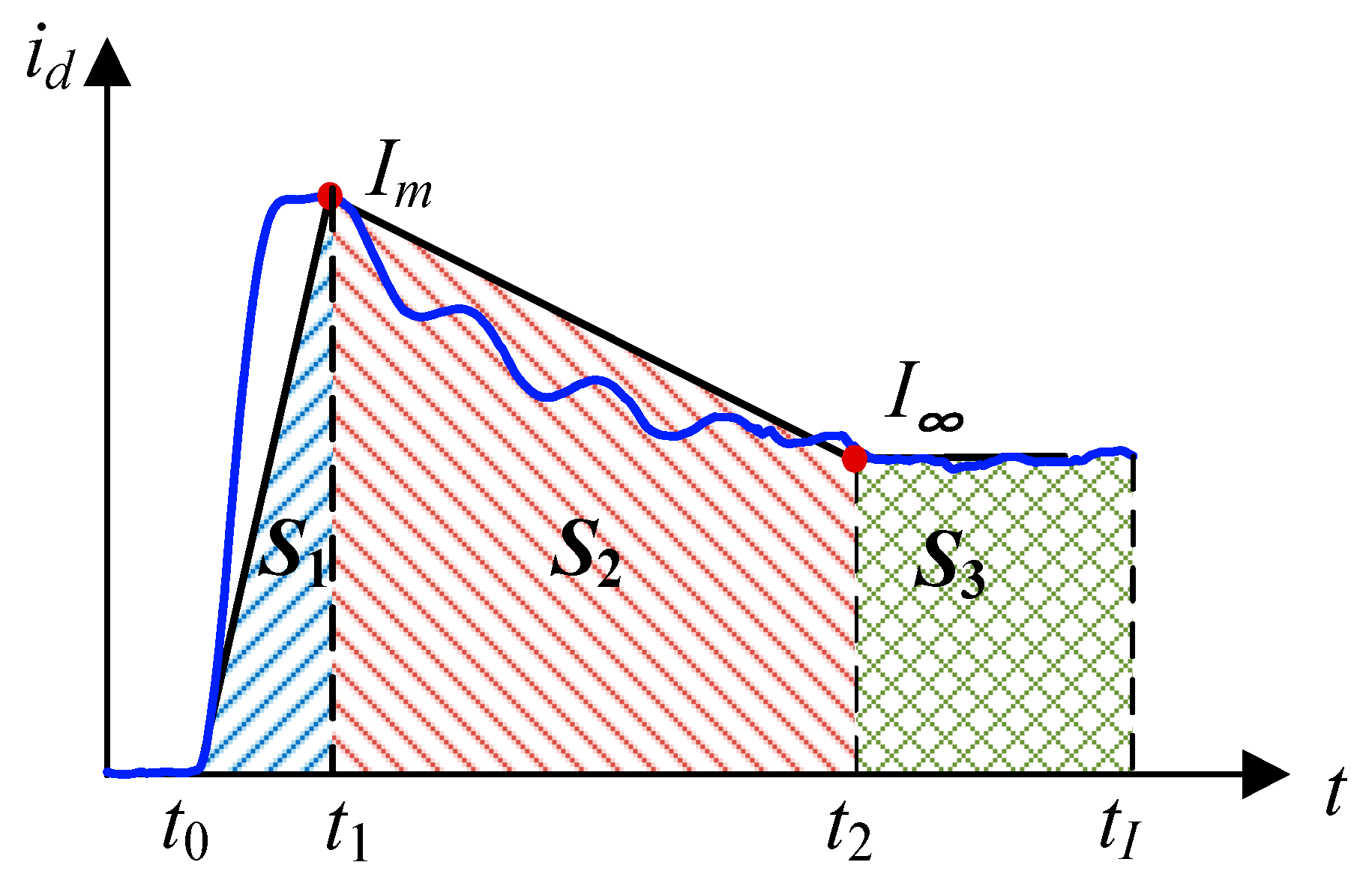


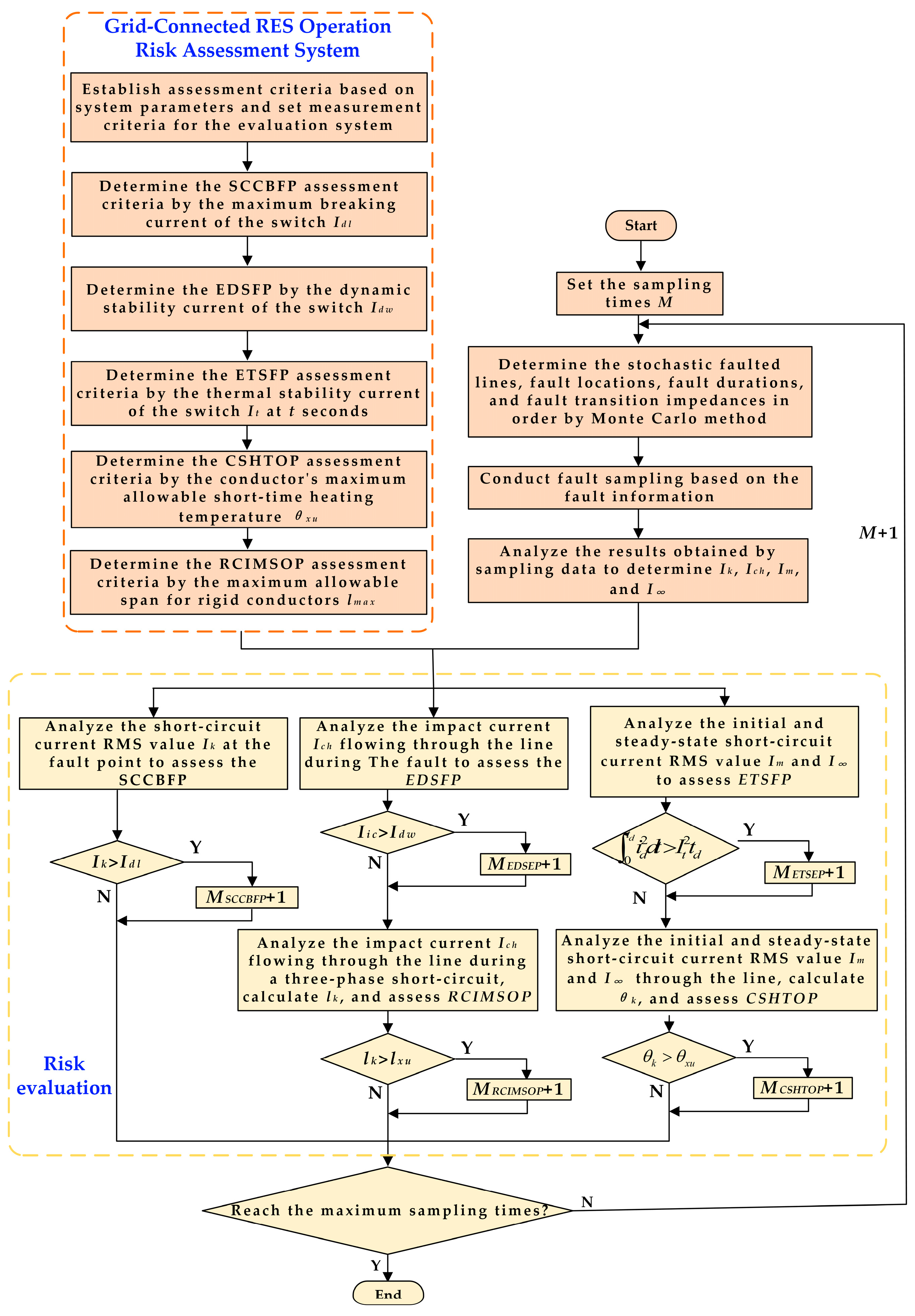



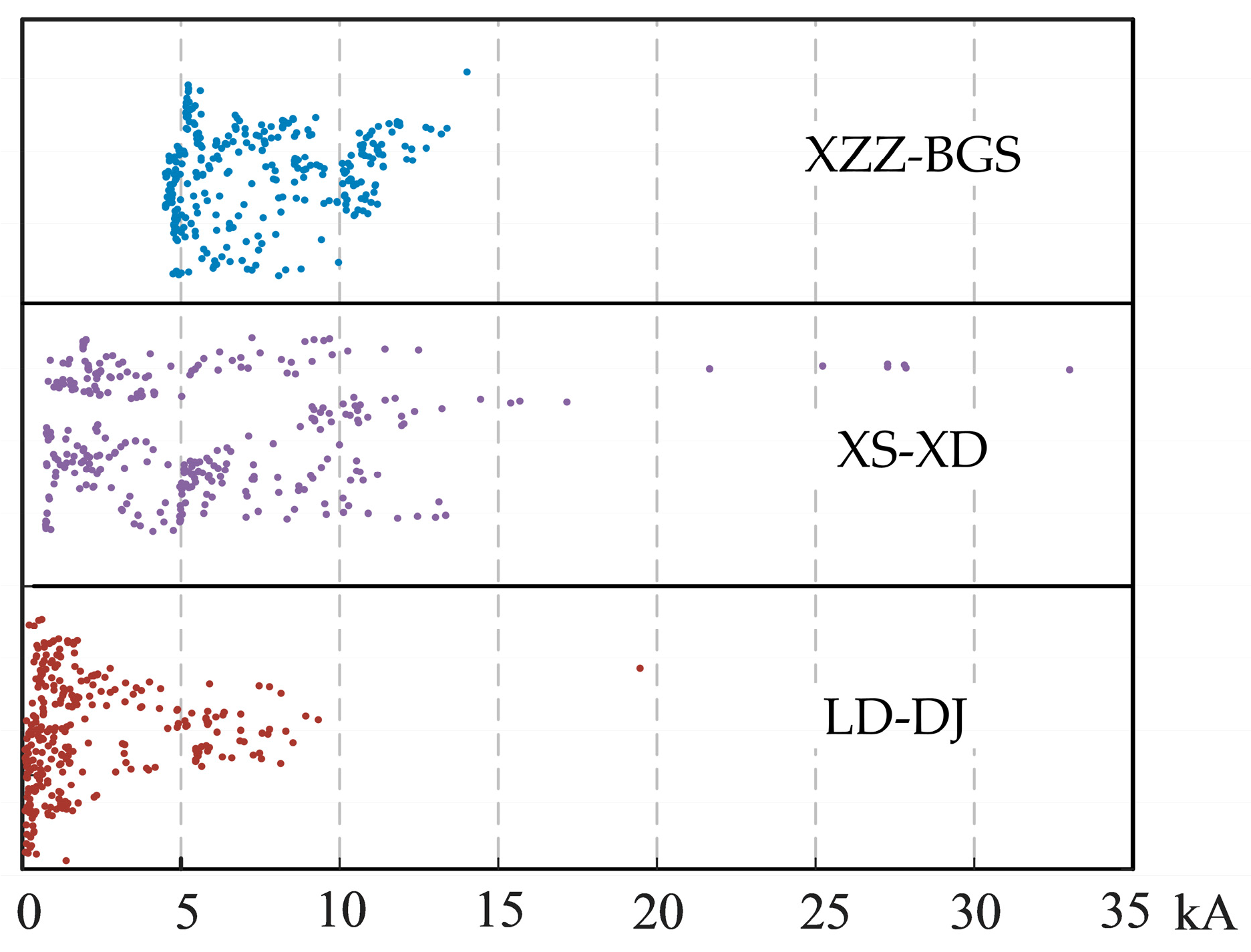
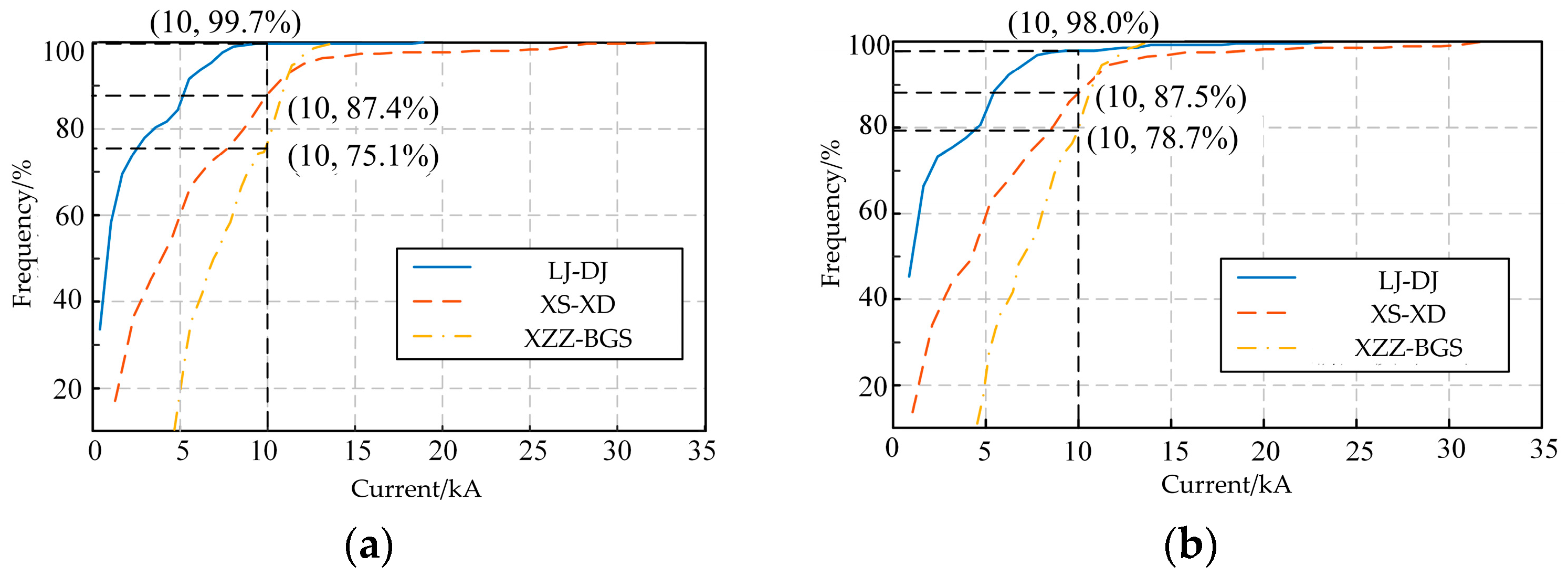
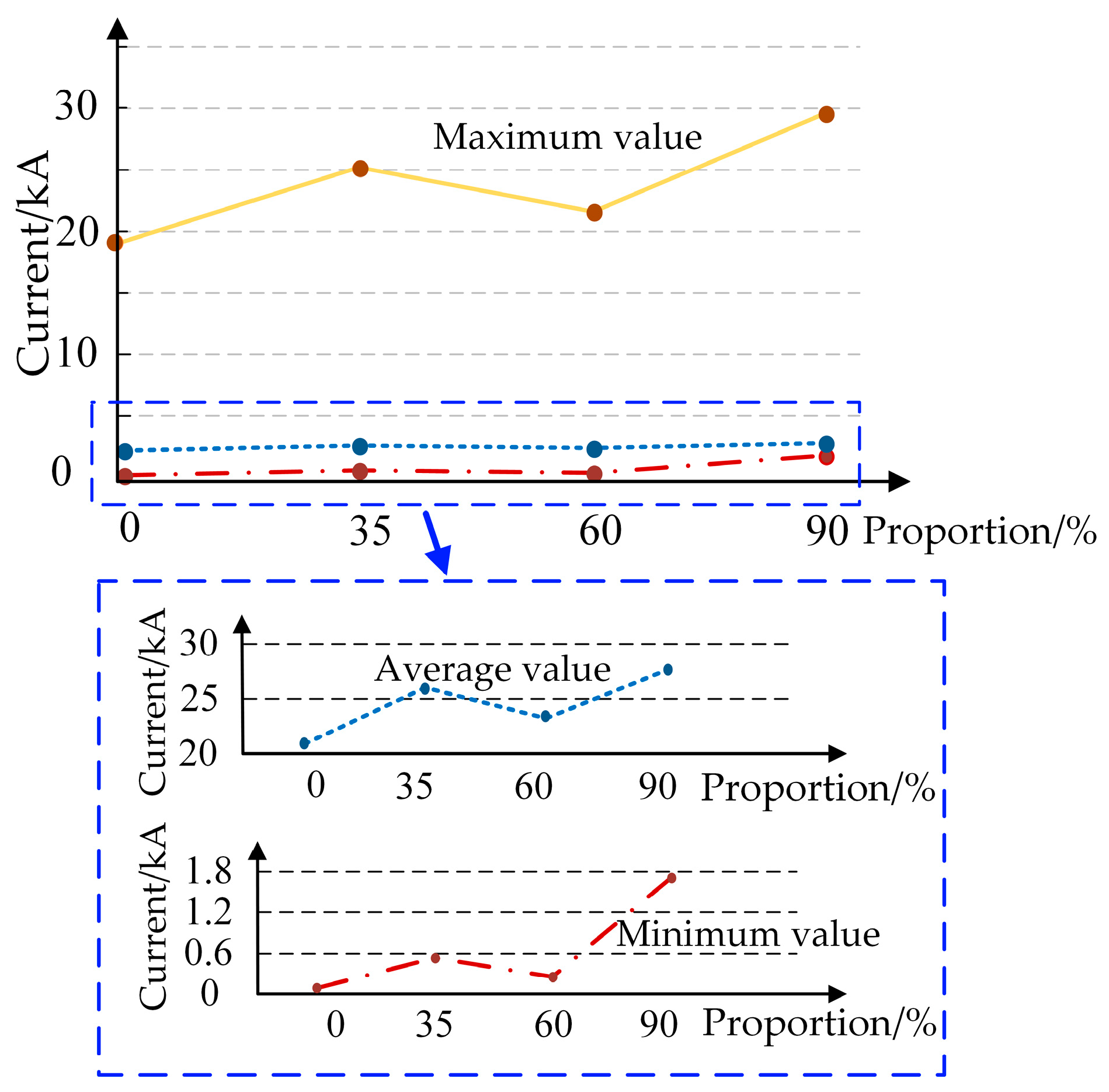
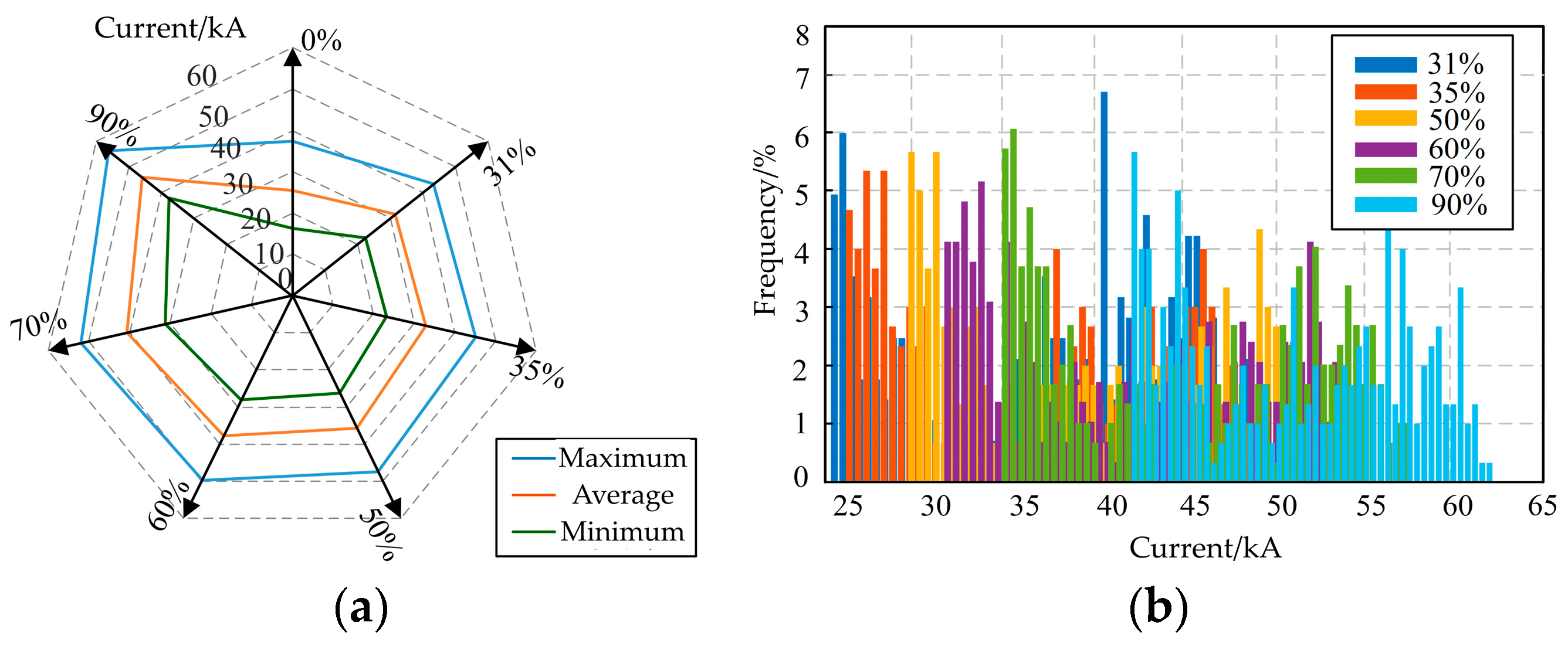
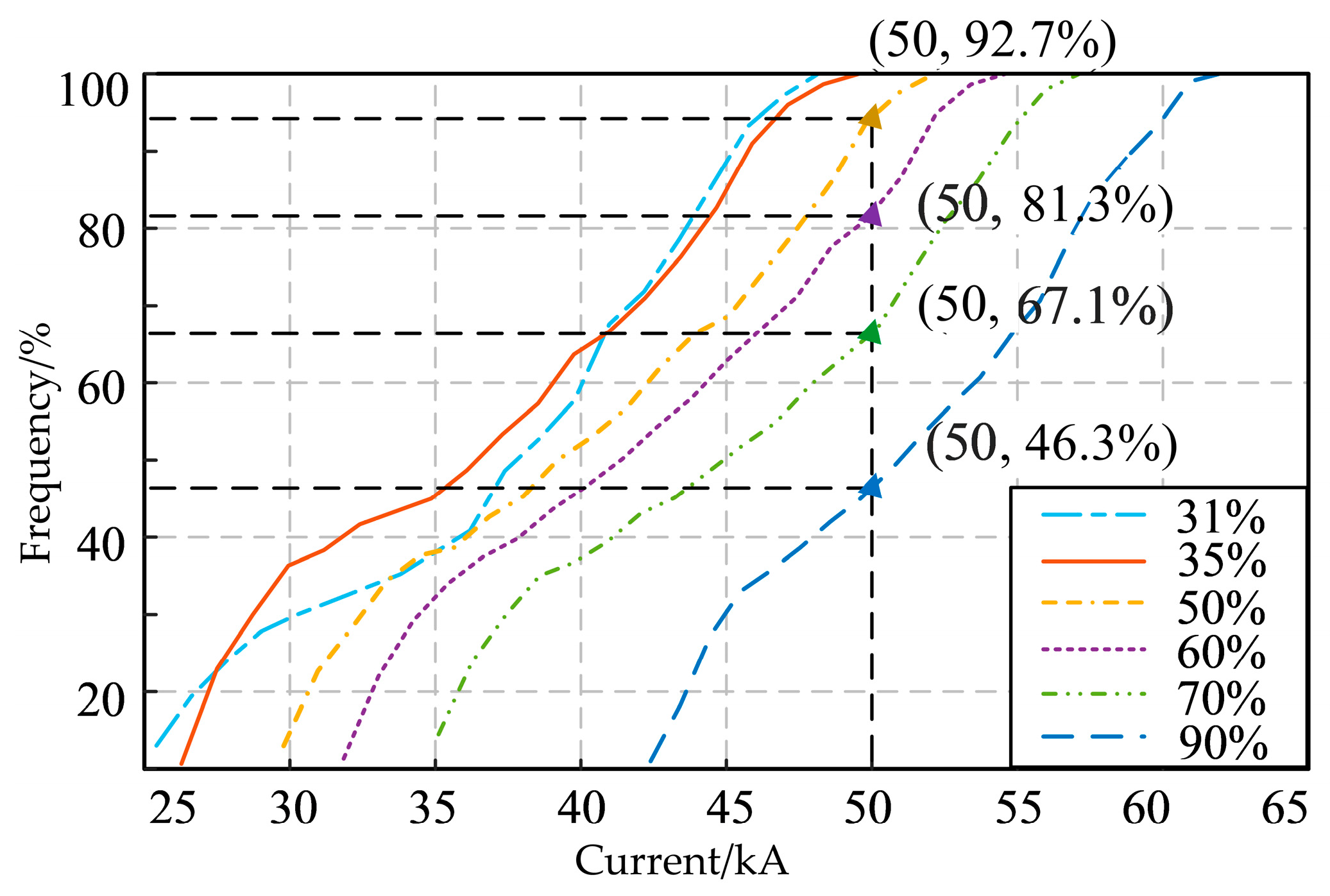
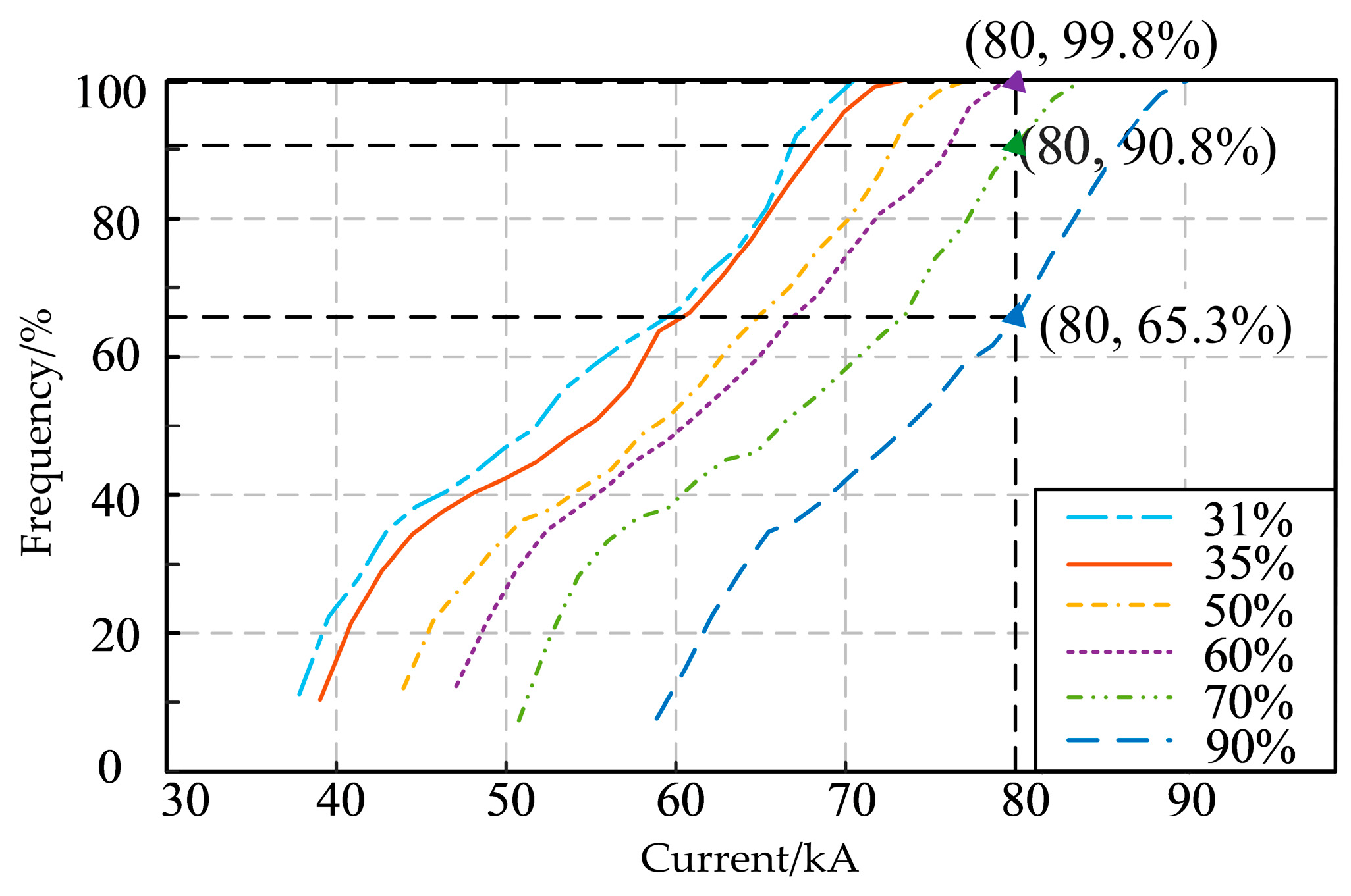

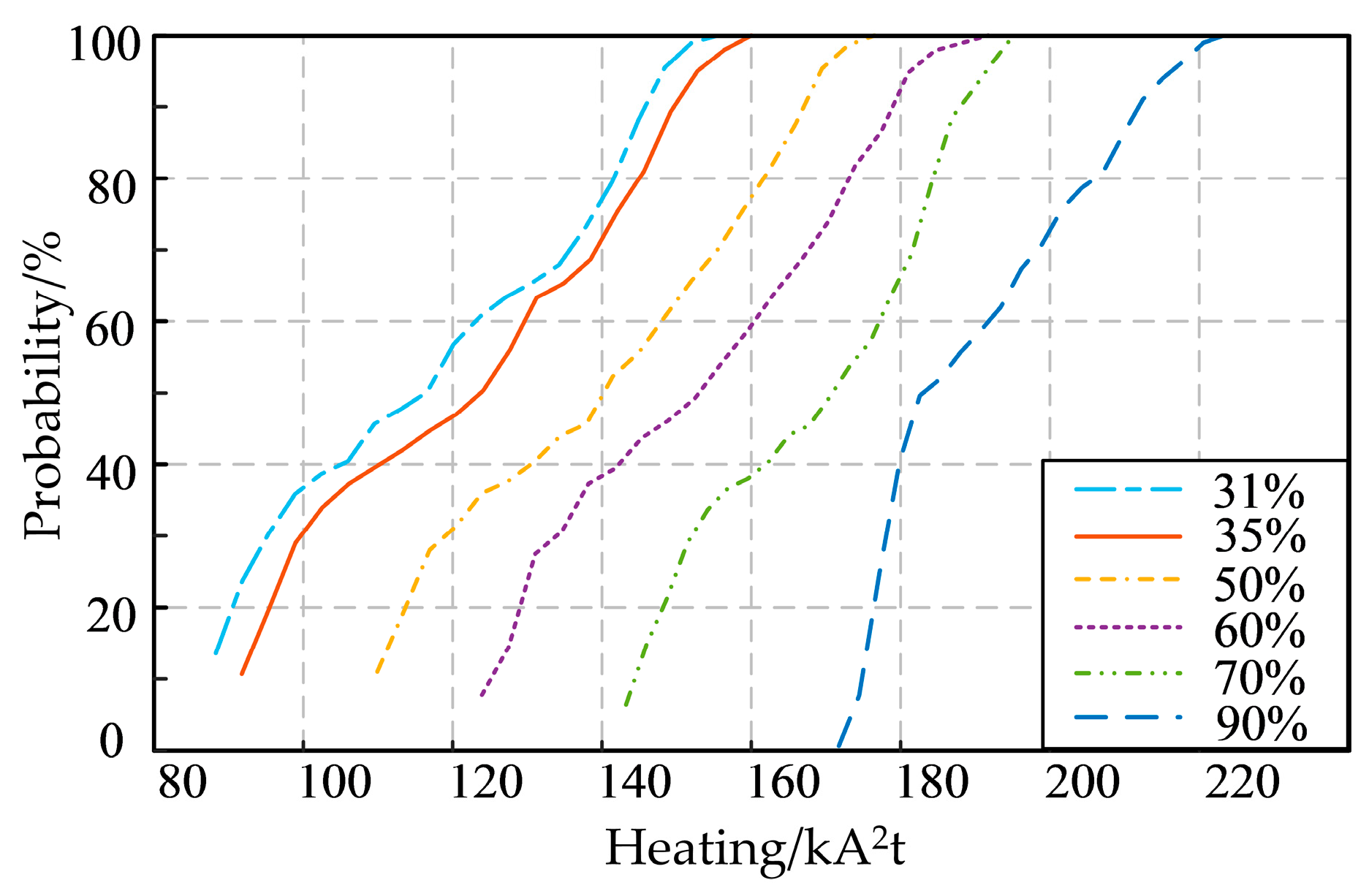
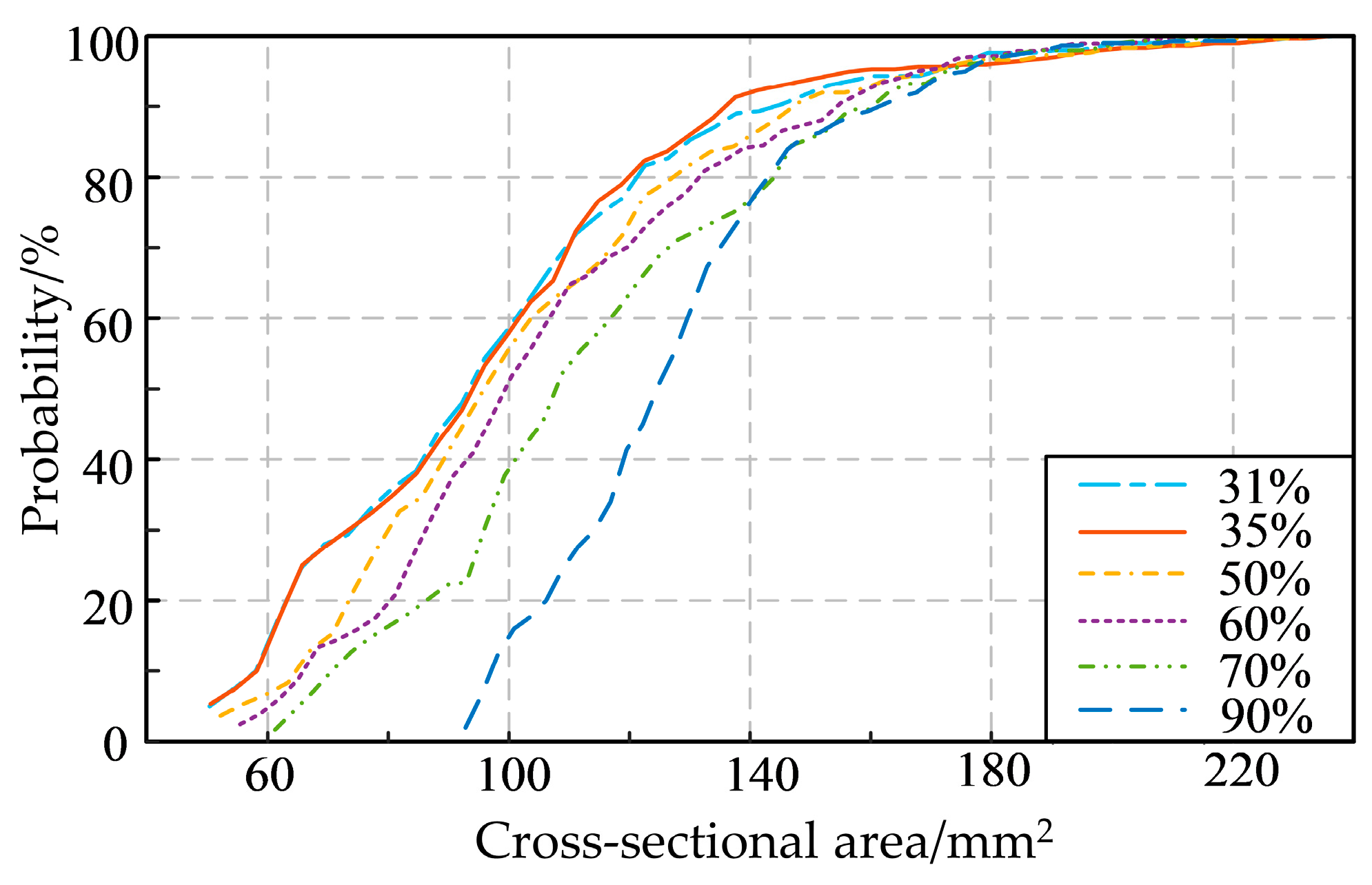
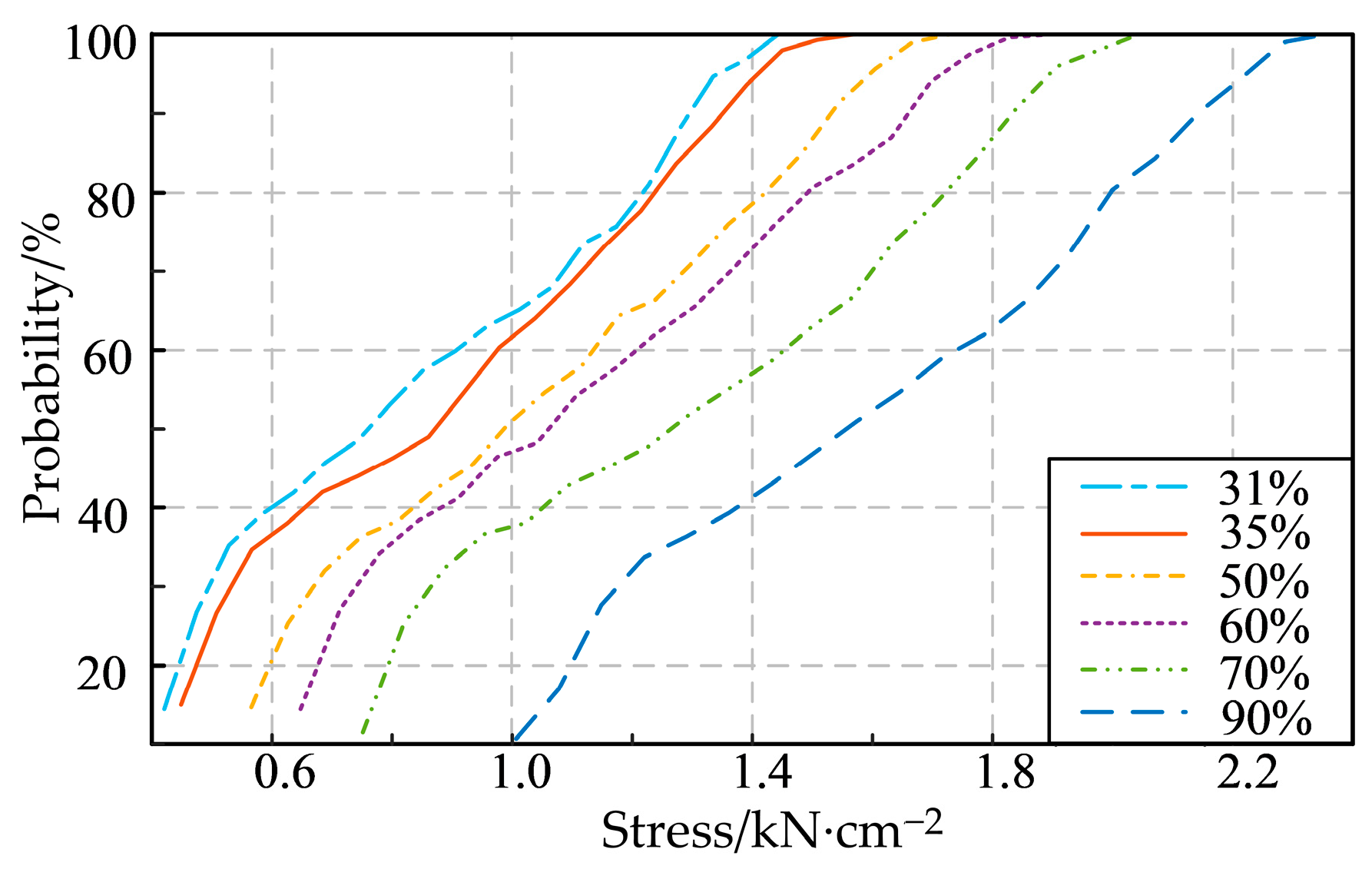
| Parameter | Basis | |
|---|---|---|
| Faulted line | Gaussian kernel density estimation [29] | Historic fault data |
| Fault location of the fault line | Gaussian kernel density estimation [29] | Historic fault data |
| Fault duration | Normal distribution | Reference [30] |
| Fault transition independence | Truncated normal distribution | Reference [30] |
| Parameter | Value |
|---|---|
| Model | LW53-252/3150 |
| Rated voltage/kV | 252 |
| Rated current/kA | 3150 |
| Rated breaking current/kA | 50 |
| Dynamic stability current/kA | 125 |
| Thermal stability current/kA·s−1 | 50/4 |
| Parameter | Value |
|---|---|
| Model | GW4-220D/1000 |
| Rated voltage/kV | 220 |
| Rated current/kA | 1000 |
| Dynamic stability current/kA | 80 |
| Thermal stability current/kA·s−1 | 21.5/5 |
| Parameter | Value |
|---|---|
| Model | JL/G1A-300/4 |
| Calculated total cross-sectional area/mm2 | 338.99 |
| Conductor outer diameter/mm | 23.9 |
| Weight per unit length/kg·km−1 | 1131 |
| Calculated breaking force/N | 92360 |
| Elastic modulus/N/mm2 | 73000 |
| Coefficient of linear expansion/×10−6·°C−1 | 19.6 |
| DC resistance at 20 °C·Ω−1·km−1 | 0.0961 |
| Parameter | Value |
|---|---|
| Material | Aluminum–manganese alloy tube |
| Conductor size D1/D2/mm | Φ100/90 |
| Conductor cross-sectional area/mm2 | 1491 |
| Current carrying capacity at maximum allowable temperature of +70 °C/A | 2350 |
| Section modulus/cm3 | 33.8 |
| Radius of gyration/cm | 3.36 |
| Moment of inertia/cm⁴ | 169 |
| Phase-to-phase distance/m | 3 |
| Span length/cm | 1300 |
| Allowable stress of material/N·cm−2 | 8820 |
Disclaimer/Publisher’s Note: The statements, opinions and data contained in all publications are solely those of the individual author(s) and contributor(s) and not of MDPI and/or the editor(s). MDPI and/or the editor(s) disclaim responsibility for any injury to people or property resulting from any ideas, methods, instructions or products referred to in the content. |
© 2024 by the authors. Licensee MDPI, Basel, Switzerland. This article is an open access article distributed under the terms and conditions of the Creative Commons Attribution (CC BY) license (https://creativecommons.org/licenses/by/4.0/).
Share and Cite
Qian, W.; Zhang, R.; Zou, Y.; Zhou, N.; Wang, Q.; Yang, T. Quantifying the Inverter-Interfaced Renewable Energy Critical Integration Capacity of a Power Grid Based on Short-Circuit Current Over-Limits Probability. Electronics 2024, 13, 1486. https://doi.org/10.3390/electronics13081486
Qian W, Zhang R, Zou Y, Zhou N, Wang Q, Yang T. Quantifying the Inverter-Interfaced Renewable Energy Critical Integration Capacity of a Power Grid Based on Short-Circuit Current Over-Limits Probability. Electronics. 2024; 13(8):1486. https://doi.org/10.3390/electronics13081486
Chicago/Turabian StyleQian, Weiyan, Ruixuan Zhang, Yao Zou, Niancheng Zhou, Qianggang Wang, and Ting Yang. 2024. "Quantifying the Inverter-Interfaced Renewable Energy Critical Integration Capacity of a Power Grid Based on Short-Circuit Current Over-Limits Probability" Electronics 13, no. 8: 1486. https://doi.org/10.3390/electronics13081486





